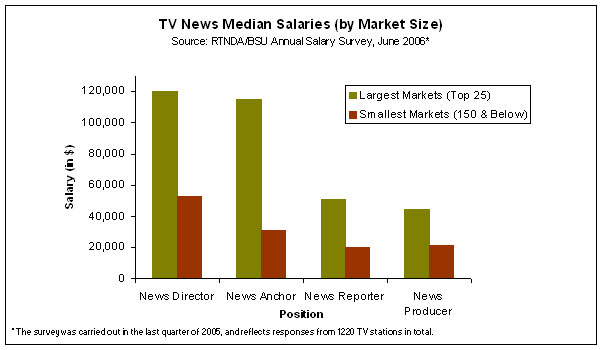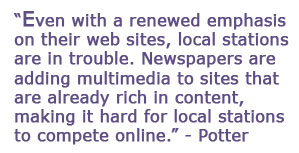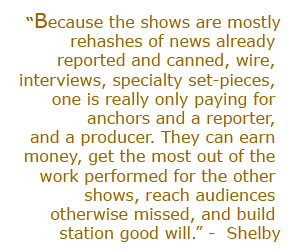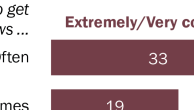For many years, television news flourished as a dominant local platform with very healthy profit margins, big franchises in sports and weather, and loyal audiences. But now it confronts a rapidly evolving news landscape. In the past decade, the percentage of people who say they regularly watch local news has slipped from nearly two out of every three to slightly more than one out two. At the same time, the number of viewers who say they believe all or most of what they see on their local newscast has dropped significantly in recent years. And much of the local TV news hole is now filled with crime and accident stories according to the Project for Excellence in Journalism’s “State of the News Media 2006” study.
Despite these challenges, local television still provides attractive career opportunities for journalists, especially in the bigger markets where the salaries far outstrip those in smaller communities. As the PEJ has stated in this year’s annual report, news directors continue to be the dominant and best compensated staffers in the newsroom.

In this, the Project for Excellence in Journalism’s fifth roundtable on the State of the News Media, local TV news experts say the industry will have to creatively adapt to new marketplace realities and they also express concerns about a business that has become addicted to high profit margins.
The panelists for this roundtable were:
- Bob Chirdon, Vice President and General Manager, WTOL Channel 11, Toledo, Ohio. With a Bachelor of Science in Journalism from Ohio University, Mr. Chirdon has worked in television for 25 years. After beginning his career as a local account executive, he joined WTOL, a CBS affiliate, in 1999 as General Sales Manager overseeing all advertising sales functions. He was named VP/General Manager of WTOL in July of 2001.
- Scott Libin, Leadership & Management Faculty, Poynter Institute: Mr. Libin is currently teaching at The Poynter Institute for Media Studies in St. Petersburg, Florida, where he leads seminars for journalists. He began work at Poynter in 1995 after nine years at WGHP-TV (NC), where he was vice president of news. He was also news director of KSTP-TV from 1998-2003, in Minneapolis-St. Paul.
- Kay Miller, News Director, WWSB TV: Ms. Miller has been at WWSB (ABC, Channel 40) in Sarasota, Florida since 1997, and moved up the ranks from Assignment Manger to News Manager to News Director in 2001. She oversees 40 employees and under her tenure, ‘News 40’ has won the Associate Press awards for best newscast and best overall news product for two years in a row.
- Deborah Potter, President and Executive Director, News Lab: Ms. Potter is a journalist and educator who spent 16 years as a network correspondent for CBS and CNN. Since 1998, she has been executive director of NewsLab, a non-profit journalism training and research center in Washington, D.C.
- Don Shelby, Anchor/ Reporter, WCCO-TV: Mr. Shelby joined WCCO (CBS, Channel 4) in Twin Cities, Minnesota in 1978. In his career as an anchor and reporter, he has won all five of the nation’s top journalism awards, including three national Emmy’s and two Peabody’s.
1. There’s been talk about how local TV stations are moving from a broadcast-centered model to a viewer-centered one, where viewers not only determine what is aired but when. What do you think of that, and what effect will it have on local newsrooms?
DON SHELBY: When we turn over that kind of control to the audience, we might as well pack up our tents, the fun is over. We are in our positions of authority because we have the task of ordering the discussion. Sometimes we do that well, and sometimes not so well. We do it worst when we are chasing a goal other than providing the viewer with the best possible information upon which they can develop an informed opinion. Left alone to decide, I’m not sure if the lead story might be the sex of Tom and Katie’s baby. Of course, all that changes when the stuff hits the fan. When it does, the audience turns to us to find out the important information. If we get out of that practice, and forget how to do it, we won’t have it when they ask.
BOB CHIRDON: I think it is scary. We may attract viewers one viewer at a time, but serving viewers one demand at a time will make us insane. In the end, we must make judgments about content that both capture the news of the day and enhance and support our brand. We must make these efforts available when requested. But the decision about which story is worthy and how we tell it in an interesting way remains our last grasp to remain relevant.
SCOTT LIBIN: I believe there remains a role for editorial decision-making by journalists. Viewers are bombarded by information 24 hours a day. While they insist on choice and customization, they also recognize the value of assistance in sorting through sources and stories. Convenience, on the other hand, will only grow as a viewer priority. I believe traditionally scheduled newscasts will lose audience to products delivered along non-traditional streams, available when and where customers want them. Television stations will want to be the ones delivering such products, rather than allowing others to take that business away.
[Actually,]
[the assertion poised is]
2. How much confidence do you have that traditional mainstream media organizations (like local TV) will survive and thrive in the transition to the Internet?
DEBORAH POTTER: I’m fairly confident they will survive. I think branding counts. People know what brands they can trust, whether it’s the make of a car or the name of a news organization. But the key is to maintain trust by providing a reliable, accurate, and up-to-date news product, no matter the platform.
[But further out]
Rather than abandon hard news, as some stations have done, this is an opportunity to do a better job of explaining the stories they’ve read. I’m fond of terms like, “What that means,” and “We’ll explain how that works.” The audience is inundated with news, but very little context or explanation. We talk either beneath the viewer or way over their heads. I think we can meet the viewer on his or her terms. “Tell me what all this means,” is what I hear them saying.
SCOTT LIBIN: I’d choose a term somewhere between “survive” and “thrive” – perhaps evolve or adapt, as radio did decades ago with the advent of television. I still see a “unique selling proposition” offered by mainstream media organizations, and history indicates that new forms of media will siphon off audience but not entirely replace old forms.
There have already been casualties, of course, and there will be more, but I think news consumers recognize the gatekeeper function of mainstream media, perhaps now more than ever. Yes, people like to choose their own news sometimes. At other times, I believe they still value having a trusted news organization sort through the barrage of information available and provide an edited array of stories.
BOB CHIRDON: Amazing to me, broadcast efforts to create a successful dot-com operation were originally all about written content. In the end, many of these television sites became indistinguishable from newspaper sites, except the newspaper sites were much better written. This misstep ignored the one hugely significant advantage we have… we know how to do video. And, as we are rapidly discovering, it is the combination of interesting video and well-written content (isn’t that where we are supposed to excel?) that is available whenever it is requested, that will bring new unique users who, in turn, can be exposed to an advertiser’s product.
The danger for broadcast is that the newspaper industry has cracked the code… we see the trend within newspaper organizations to create video news teams whose only purpose is to provide news video to stream on the paper’s website. The battle has truly been joined. The victor may well be the organization that purchases and installs the fastest and best technology relative to server speed and ease of downloading and use. This is problematic since the expense will be great. Since most broadcast organizations have a spotty record of generating dot-com revenue, there may be huge resistance to negatively impacting the bottom line by investing in an uncertain product with speculative potential to increase unique users.
Who will win? My sense is the newspaper industry may well be more immediately motivated by FEAR. If that is the case, the survival instinct will outweigh the immediacy of protecting cash flow and the investment in technology will take place.
KAY MILLER: Not very well…we still don’t know how to translate everything we do quickly enough to the internet and mainstream America needs their computers to be as robust as the video we are trying to send…because let’s face it…it’s all about the video.
I think GMs and media in general are still not willing to devote enough financial resources to producing for the web. Just this last weekend there were huge brush fires in our area and not one website from Tampa Bay to Ft. Meyers had anything on their site until hours after the fires started. I know they knew about it but they probably didn’t have anyone working on the web over the weekend. If they didn’t know and that’s why it wasn’t on the web then that’s a whole other problem entirely…
3. What has prevented local TV stations from gaining the online presence that many local newspapers now have?
DEBORAH POTTER: Most local stations don’t have the staff they need to produce quality news on their “main platform,” much less online. For too long, they saw the web as a promotional tool, not a way to extend their journalism. They’re changing their approach now—Fox is hiring multiple web producers for each of its owned stations—but it may be a little late.
SCOTT LIBIN: Local newspapers have vastly larger news staffs and lower profit expectations. They also got seriously into online coverage sooner, in most cases. Stations have become and will continue to grow as a competitive source of online coverage when they re-engineer their newsrooms and redeploy their resources in order to reach the daytime online audience with material that is fresh, interesting and unavailable elsewhere.
KAY MILLER: Resources dedicated to exclusively working on the web. Many smaller markets rely on overwhelmed producers to update the web. Instead, what good web production needs is a staff and budget allocated to working with the news department to enhance, promote and break the news. I believe stations are inherently capable of having great web sites – we are used to constant deadlines and the idea of breaking news – it’s a natural fit. Once stations dedicate some resources they will quickly realize that the viewers will respond and then advertisers will see the benefit as well.
BOB CHIRDON: In the beginning, television tried to do newspapers online. It didn’t work. Newspapers have more resources and those resources are all about the written word. Now, television stations are providing instant video that is compelling and interesting. Local stories of high interest are streamed in combination with written content. Look for newspapers to try to become television stations online- television should compete much better in this arena.
4. Do others agree with Bob that newspaper web sites will eventually further threaten local TV as they become more multi-media?
KAY MILLER: Definitely not
SCOTT LIBIN: Yes, if TV stations do not respond effectively, newspapers will take away their local video franchise.

DEBORAH POTTER: Even with a renewed emphasis on their web sites, local stations are in trouble. Newspapers are adding multimedia to sites that are already rich in content, making it hard for local stations to compete online. They just don’t have the horses to produce as much journalism.
DON SHELBY: Before local newspapers can supplant local television stations, newspapers will have to figure out how to make the old money from the new environment. It is not inconceivable that newspapers will not be paper at all in the future. The newspaper will arrive by modem or cable at the kitchen table. And, because of the nature of television, its personal element, those connections with a face and voice will not be, in my opinion, replaced by the printed press.
5. Local TV news continues to be enormously profitable, yet there is concern that they may be risking their future by continuing to insist on huge profits instead of investing in the product onscreen and online when the audience is stagnant and competition is growing. In other words, the industry may be repeating the mistakes some critics think newspapers made. What do you think?
DEBORAH POTTER: I agree completely.
SCOTT LIBIN: I agree.
KAY MILLER: That is certainly not the case at my station. Our company (privately owned) has invested a ton of money into our product and newsgathering equipment. But I do see stations that look the same as they did 10 years ago and stations that haven’t seen a dime in years. In fact, our company just acquired another station and I do know that it was severely neglected for profit reasons.
BOB CHIRDON: I think some of the biggest dangers to the future of broadcast are arrogance, ignorance, complacence and intransigence. In many respects, we are in danger of becoming the last person standing when the music stops.
DON SHELBY: I think the profits required of local stations are stunning. When one shares the margin required with other businesses, they simply can’t believe the figures. Flexibility in the margin is the key. Newsrooms cannot be threatened with retrenchment when margins fall a couple of percentage points. Fortunately, I think CBS, for whom I work, has seen the value of returning profits for reinvestment. At least at CBS I think they learned, before the newspapers learned, or because of them, to keep putting money in product in order to get the money out.
6. What is the potential of local morning news programs? Are audiences there large enough to stem the fall in evening news numbers?
BOB CHIRDON: The morning is the new prime time offering a cross-section of psychographic and demographic profiles that are generally assigned to prime-time viewers. The audience is growing but it is not about size. It is the profile of the morning news viewer that makes it a highly desirable place for advertisers to sell products.

DON SHELBY: Morning news locally can be successful. We have four important shows in this market. They hustle for about a ten rating, but because the shows are mostly rehashes of news already reported and canned, wire, interviews, specialty set-pieces, one is really only paying for anchors and a reporter, and a producer. They can earn money, get the most out of the work performed for the other shows, reach audiences otherwise missed, and build station good will.
KAY MILLER: Yes and Yes. I think the shift makes sense, especially for my community and the state of Florida. I think as the population shift occurs with the baby boomers out-numbering the younger demo, this shift will occur in the next 5-10 years (baby boomers, along with women 18-49, will go to bed early and wake up early).

SCOTT LIBIN: I don’t know whether morning audiences are themselves large enough to offset the loss of evening numbers, but I believe the impact of morning news should be interpreted more broadly. A station can’t sell enough commercials in Oprah to pay for rights to the show, but when the program’s value as a news lead-in is factored in, the station is likely to consider it a wise purchase. Similarly, stations that learn to produce and support their morning newscasts properly can use them as promotional platforms to build daytime online use of station sites, which in turn provide opportunity to drive after-work audiences. No television station I know of is effectively doing this yet, but many are beginning to recognize that stations that win in the morning also win in other key day parts.
DEBORAH POTTER: No matter how large the morning news audience is, it can’t “stem the fall” in the evening. But those numbers can keep a news department afloat, as we’ve clearly seen at the network level. The Today Show makes about half the money that all of NBC (including entertainment) makes. I haven’t seen local data that’s anywhere near that impressive, but I wouldn’t discount the importance of a strong morning news audience.
7. One broad trend we sense is the paradox of more outlets, as resources get stretched, covering fewer stories. How do you view this?
KAY MILLER: I hate to be so blunt but I believe cable television has destroyed traditional journalism. In the same breath, though, I have to thank them for entering into our markets. They beat every story to death to the point that I can’t stand to hear one more word about gators, runaway brides or missing white women. By the time our viewers tune into us they don’t want to hear those stories and that is why I thank them. They are doing local television stations a big favor – now I don’t have to cover those stories and can focus on my community and what’s REALLY important to my viewers. My viewers are smart enough to change the channel when they have had enough, now it’s my job to get them to change the channel to my station.
DEBORAH POTTER: I’m not sure I see it quite that way. Network newscasts, for example, will all cover a few of the same big stories but their lineups are not nearly as much in lock step as they used to be. Local stations do still cover many of the same stories, but that has more to do with their budgetary constraints than with the proliferation of outlets.
[either]
BOB CHIRDON: The trend is still reversible. But, the trend is real and has real consequences. When everybody does the same stories in the same way, brand differentiation becomes very difficult to sustain. This results in a leveling of the playing field in the mind of the viewer. “Everybody does that” and “Everybody has that” are common refrains we hear in focus groups and in research. This mindset is particularly injurious to the market leader who is apt to experience ratings erosion and less hardcore loyalty, which impacts the bottom line. Inside the newsroom, the management team must guard against falling prey to a “me-tooism” decision-making process where story selection and development is too often influenced by competitive pressures to cover what the other guys have. This necessarily diminishes the quality of journalism. I think that the networks need to counter this trend by developing a news brand that offers differentiation and choice to viewers. The most obvious example of successfully pulling this off is the Fox News Network.
DON SHELBY: Generally speaking, the trend is well underway. Here in Minneapolis/St. Paul, there has been something of a change. Yes, the big news events of the day are covered by everyone. The days of the exclusive lead early is something of a bygone era. However, there is a trend here at WCCO-TV to enterprise the lead if nothing else is breaking. By doing that, we resist the temptation to elevate by drama a story of an otherwise vanilla nature. We shorten the first section of the news, news of the day, and concentrate on our discretionary section where we deal with longer-form stories. The success of that method has rather grown our newsroom, and not reduced it.
BOB CHIRDON (continues) Locally, stations must first acknowledge this trend exists, which is difficult since it requires dispassionate and painful introspection. Then, with the goal of creating a sustainable brand that is based on differentiation and choice, a clear plan must be put in place that provides a road map to living the brand. Again, a difficult task; for when a path is chosen, other paths become less important. And, in choosing, you could always be wrong! – which places great value on proper and timely research. The batting average for path choosing will be much higher if research helps determine the path. By way of example, one way in which a local station can counter the trend to cover only big stories in a predictable way, is practicing advocacy journalism. Some permutation of ‘taking action getting results’ ‘investigating problems getting results’ at least holds the promise of brand differentiation and offers the potential for high-touch, high-viewer impact that can cut through the confusion.
KAY MILLER (continues) On another note, my thoughts on convergence: when the Detroit Free Press and Detroit News merged, I worried. When the Houston Chronicle and the Houston Post merged, I worried more. When convergence started becoming popular, I worried even more. I am not one who supports the notion of media all melting into one big melting pot. I like the idea of competitive media – of no one working together (paper/TV), of the good old days when you sent your folks out on the street and came back with something you wouldn’t see on another station because you scooped them all.
Lately, I see sameness everywhere. Everyone has the same top story, then that story is the top story on the website, and then it’s the top story in the paper the next day. Yes, in theory convergence was designed to enhance the story – all of those resources dedicated to covering the story more in depth – but the story is not important, the context is. I think that’s the big difference. In depth doesn’t mean I (will) care – the context of the in-depth story is what makes me care and that is exactly what is missing.
8. If there were one thing you could change about the Local TV News industry, what would it be?

DON SHELBY: The elevation of youth. Whether that elevation is because younger people can be hired for less money, or because there is some misguided effort to appeal to a demo, I don’t know. However, if journalism survives on television it will be because it has earned and kept trust and credibility. It takes a long time to earn that. If I could change the nature of the segmenting of the audience for the purposes of ratings, that is, the demo, 18-35 female, I think we might have a better chance at ordering a newscast without resorting to the kind of pandering for viewers we see so often.
[I would ask schools]
BOB CHIRDON: The rules regarding cross-ownership within a market should be changed so that more opportunities existed to form partnerships in newsgathering and revenue development.
SCOTT LIBIN: It would be to lower shareholder’s short-term profit expectations in order to encourage investment in the long-term interests of media companies and the communities they serve. Unfortunately, convincing business people to make less money under any circumstances – even temporarily — is a tough sell, and those of us with retirement accounts invested in media companies don’t generally mind the returns they provide.
DEBORAH POTTER: I agree with Scott that the profit pressures are enormous, but I’m not sure business people need to be convinced to make less money. Instead, they need to see how investing in their businesses can make them more money. There’s a lesson to be learned from the experience of the New York Times during World War II, when newsprint was rationed. The Times, unlike other papers, chose to print more news and fewer ads, building a loyal readership and a long-term powerhouse of a newspaper. If I could change one thing about local TV, it would be its short-term focus.
If you would like to offer your own thoughts on the future of local TV news, please email us at mail@www.pewresearch.org/pewresearch-org/journalism. We will then compile and post a selection of responses.




